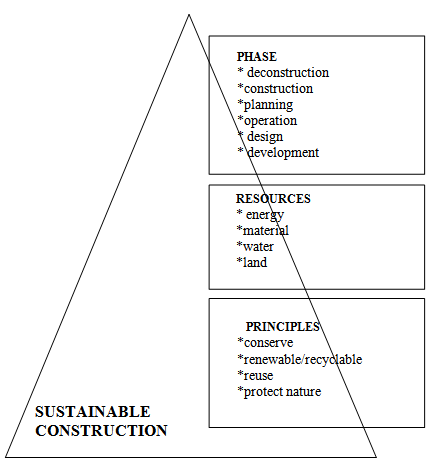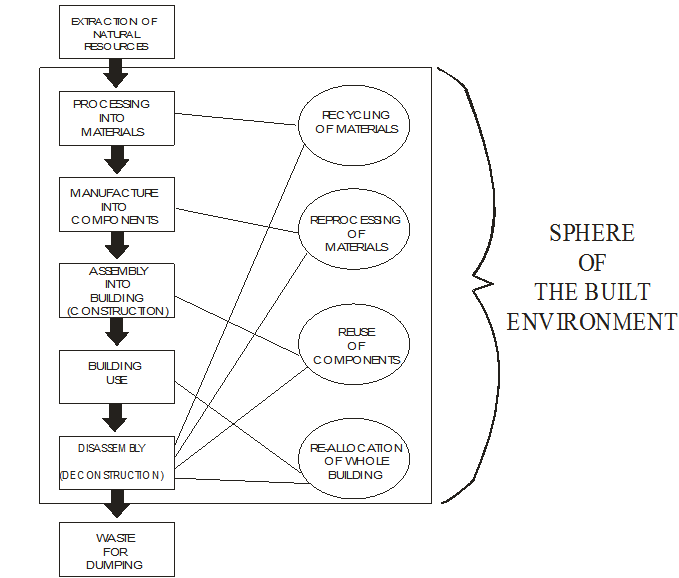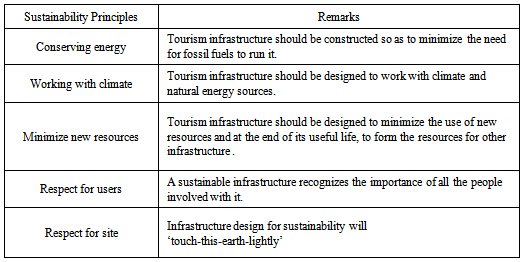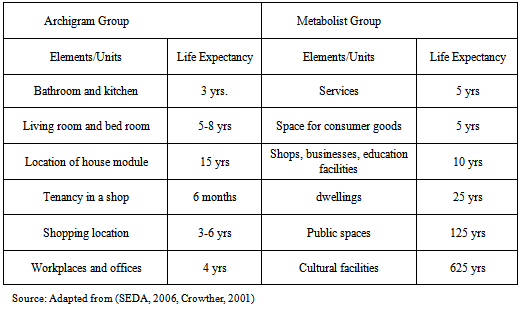-
Paper Information
- Previous Paper
- Paper Submission
-
Journal Information
- About This Journal
- Editorial Board
- Current Issue
- Archive
- Author Guidelines
- Contact Us
American Journal of Tourism Management
p-ISSN: 2326-0637 e-ISSN: 2326-0645
2014; 3(1A): 13-19
doi:10.5923/s.tourism.201401.03
Optimizing the Sustainability of Tourism Infrastructure in Nigeria through Design for Deconstruction Framework
Anthony K. Adebayo, Anthony C. O. Iweka
Department of Architecture, Faculty of Environment Sciences, University of Lagos, Akoka-Yaba, Lagos, Nigeria
Correspondence to: Anthony C. O. Iweka, Department of Architecture, Faculty of Environment Sciences, University of Lagos, Akoka-Yaba, Lagos, Nigeria.
| Email: |  |
Copyright © 2012 Scientific & Academic Publishing. All Rights Reserved.
Tourism infrastructure is generally regarded as the physical element that is created or made to cater for visitors. The way in which design and construction of tourism infrastructure, particularly buildings are currently carried out in Nigeria tends to be haphazard, wasteful and largely unscientific. One major observation is that most tourism infrastructure in the country are not designed for ease of disassembly, thereby creating sustainability problems for designers and other stakeholders. The negative environmental impacts of wastages associated with such design and construction practices are substantial and this could exacerbate, considering the high rate of urbanization and the present quest to be among the twenty most industrialized nations in the World by 2020. The implication of the 2020 agenda is that the tourism industry in Nigeria would witness unprecedented construction activities. Considering the present experience of the industrialized countries, the current construction activities inherent in tourism infrastructure are associated with huge amount of waste. Experiences of most industrialized nations seem to suggest that such wastes can be avoided or reduced by increasing the rates of reuse and recycling of materials and components. As the economy of Nigeria continues to expand, there is growing need to explore the problems of sustainability associated with design and construction of tourism infrastructure. The methodology for this research is essentially a literature review that explores design for deconstruction as a paradigm for developing sustainable tourism infrastructure in Nigeria. The study reveals that re-use of existing tourism infrastructure through mass recycling of associated wastes could introduce elements of sustainability into the sector. It concludes that application of design for deconstruction framework will heighten awareness for elements of sustainability that a tourism infrastructure project needs to objectify in 21st Century Nigeria.
Keywords: Deconstruction, Disassembly, Tourism Infrastructure, Sustainable Infrastructure, Reuse
Cite this paper: Anthony K. Adebayo, Anthony C. O. Iweka, Optimizing the Sustainability of Tourism Infrastructure in Nigeria through Design for Deconstruction Framework, American Journal of Tourism Management, Vol. 3 No. 1A, 2014, pp. 13-19. doi: 10.5923/s.tourism.201401.03.
Article Outline
1. Introduction
- Tourism infrastructure can be regarded as the physical elements that are designed and erected to cater for visitors. The strong link between tourism development and infrastructure has been theoretically established by a number of authors (Seetanah, et al. 2011; Imikan & Ekpo, 2012; Tampakis, Manolas & Tampakis, 2012). Imikan and Ekpo (2012) classify tourism infrastructure in terms of water, transport, electricity, communication, and accommodation. They further noted that the accommodation factor includes buildings that serve as hotels and guest houses. Seetanah et al. (2011) went further to classify rental rooms as constituting a significant part of tourism accommodation infrastructure.It is important to note that buildings that serve as tourism infrastructure are not restricted to accommodation variants. Nina (1999) for example, claims that in Australia, important infrastructure projects for tourism development included Sydney Olympic Stadia, as well as convention and exhibition centres. This wider interpretation of the building and accommodation dimension of tourism infrastructure is the focus of this paper. It is considered to be fundamental to a tourist’s overall impression of a destination. One major observation is that most tourism infrastructure in Nigeria are not designed for ease of disassembly, thereby creating sustainability problems for designers and other stakeholders. This paper explores design for deconstruction as a framework through which recycling and re-use of huge amounts of waste can be facilitated, to achieve sustainable development of tourism infrastructure in Nigeria. Design for deconstruction is an emerging concept that borrows from the fields of design for disassembly, reuse, re-manufacturing and recycling in the consumer products industries. Its overall goal is to reduce pollution impacts and increase resource and economic efficiency in the adaptation and eventual removal of constructed infrastructure, and recovery of components and materials for reuse, re-manufacturing and recycling ( Webster & Costello, 2005; Guy & Ciarimboli, 2005).Design for disassembly is a growing topic within manufacturing industries as greater attention is devoted to the management of the end-of-life of products. This need is driven by the increasing disposal problems of large amounts of consumer goods. The resultant pollutant impacts and loss of material resources and energy that emanate from these products are regarded as major reasons why Europe, for example, now places emphasis on extended producer responsibility legislation. Among such legislations are the Directive 2000/53/EC of the European Parliament on end-of-life vehicles and Germany’s End-of-Life Vehicle Act of 2002. Extended producer responsibility is a device for making manufacturers of products responsible for the entire life-cycle of their products, particularly for the take-back, recycling and final disposal of the products (Toffel, 2002; 2003). Simply put this stipulates that those who create a product are responsible for designing its entire life-cycle, including its ultimate disposition, with reuse and recycling, to achieve economic profitability at minimum risk. The elements of the 2000/53/EC related to extended producer responsibility design and manufacturing processes include:(a) Reduction and control of hazardous materials. (b) Requirements that dismantling, reuse and recycling of vehicles and components are integrated into design and production.(c) A certificate of destruction accounting for the recovery of the vehicle. (d) Use of component and materials coding standards.(e) Creation and dissemination of dismantling information for the correct and environmentally sound end-of-life treatment.(f) Measurable targets of the average amount of materials by weight per vehicle to be recovered (Directive 2000/53/EC of the European Parliament, 2006). Design for deconstruction is a new concept for professions in the built environment and is an important contributor to design for environment. Design for environment is a comprehensive consideration of design related to environmental and human health impacts over the life-cycle of a product and even beyond. These concepts are apt for the development of designs for tourism infrastructure in Nigeria. There are many other sub-sets of design for environment such as design for assembly, reuse and recycling. Although considering tourism infrastructure as a product may have varied interpretations, there is a consensus that they are nonetheless composed of materials, components, and connections. Furthermore, it is generally agreed that tourism infrastructure are created through the collaboration of designers, engineers, trade-persons, and the manufacturers of the materials and components that are assembled. Because of their importance in society and their tremendous impacts on resource utilization globally, any attempt to consider sustainability in the use of tourism infrastructure-related resources must consider the management of all resource flows in the life-cycle of tourism infrastructure from extraction, to manufacturing, to design, to construction, to operation, to renovation, to eventual end-of-life.Design for deconstruction is intended to reduce new materials consumption and waste in construction, renovation and demolition of buildings intended for tourism infrastructure. It is also intended to increase building lives in situ, and create buildings that are stocks of future building materials for the growth of tourism infrastructure (Webster & Costello, 2005). In fact, design for deconstruction is integral to any design concept that intends to maximize materials conservation from infrastructure end-of-life management, and create adaptable infrastructure. Given that many tourism infrastructure are removed from sites due to redevelopment and their inability to remain useful within an alternative land use, design for deconstruction can also be an intelligent strategy to prevent obsolescence and mitigate economic factors (such as labour costs) that encourage destructive demolition and disposal of infrastructure (Crowther, 2001; Toffel, 2003).However, one of the major hindrances to successful deconstruction, for the reuse of tourism infrastructure materials and components, is the difficulty in recovering items in good condition. Modern construction methods are very dependent on permanent fixing methods that allow for little else but destructive demolition. If tourism infrastructure were initially designed for deconstruction, it would be possible to successfully recover much more materials for reuse. This would have significant advantages both economically and environmentally.In an attempt to establish a knowledge base for understanding design for deconstruction, researchers have investigated a number of related theories and research fields (Fletcher, Popovic & Plank, 2000; Crowther, 2001; Toffel, 2002; Toffel, 2003; Kibert, 2003; Guy & Ciarimboli 2005). There are four main parts to these investigations: (a) an understanding of how design for deconstruction fits, into the broader issues of sustainable construction, (b) the theory of time related infrastructure layers, (c) the theory of a hierarchy of recycling and reuse, (d) a list of design for deconstruction principles.
2. Why Design for Deconstruction
2.1. Problems with Current Tourism Infrastructure Design Practices
- Generally, current design and construction practice of tourism infrastructure in Nigeria does not consider future proofing as a sustainable strategy, making alterations difficult or even impossible without complete demolition in majority of the cases. In other words, current design and construction methods in our country make tourism infrastructure difficult to adapt or deconstruct and also to recover the materials for reuse and recycling in a cost-effective manner.
2.2. Economic Reasons
- From the clients’ point of view, the following may be considered as reasons for using design for deconstruction: (a) to increase the flexible use and adaptation of tourism infrastructure at minimal future cost (b) to maximise the value of infrastructure, or its elements, when it is only required for a short time (c) to reduce the quantity of materials waste during construction and renovations of tourism infrastructure. (d) to minimise maintenance and upgrading costs incurred by replacement requirementsA key economic benefit of design for deconstruction is the ability of clients to future-proof their tourism infrastructure, both in terms of maintenance and any necessary upgrading, with minimum disruption and cost. The wider economic benefits to society include minimizing waste costs at all levels.
2.3. Concern for Nigeria’s Future Urbanization and Industrialization
- Nigeria is still experiencing rapid urbanization and population boom. This apart, the country is in the threshold of rapid industrialization towards 2020 and beyond. If the challenges in the tourism industries of the industrialized countries would serve as lessons for Nigeria, then there is need to incorporate design for deconstruction in its tourism sector development. While evidences of impacts of tourism infrastructure design and construction activities in Nigeria are still being investigated, lessons could be learnt from the reasons for research into design for deconstruction based on data on construction industries in the developed economies. For example, according to Wagner (2002), the United States Geological Survey has estimated that 60% of all material flow (excluding food and fuel) in the US economy is consumed by the construction industry. The United States Environmental protection agency (EPA) has estimated that 92% of all construction-related waste produced annually in the US is the result of renovations and demolitions, with only 8% produced from new construction, and that this waste is upwards of 30% of all waste produced in the US (Franklin Associates, 1998). Nelson (2004) has also estimated that the total built space in that country will need to grow from 27.53 billion square metres in 2000, to 39.71 billion square metres in 2030. Of this growth, 7.63 billion square metres of building will be from replacement of existing building space and 12.18 billion will be from new construction totalling 19.81 billion square metres of new built space. This means that 27% of existing buildings in the year 2000 will be replaced from 2000 to 2030 and that over 50% of buildings in the year 2030 will have been built since 2000 (Nelson, 2004).This huge mass of buildings that are to be replaced and newly constructed can either be large sources of waste in the next generation after 2030, or they can incorporate design for deconstruction to recover their materials from future repairs, renovations, and removals. It is obvious from the above that the Nigeria’s infrastructural development will require scientific approach if sustainable design and construction practice is considered important in the overall goals of vision 2020. The designers of Nigeria’s tourism infrastructure will therefore need to be guided by evidence-based practices from other parts of the world.
3. What is Design for Deconstruction?
- According to SEDA, (2006), design for deconstruction can be considered as the design of infrastructure to accommodate and facilitate future changes and the eventual dismantling (in part or whole) to permit recovery of systems, components and materials. This design process includes developing the assemblies, components, materials, construction techniques, and information and management systems to accomplish this goal. Design for deconstruction enables flexibility,convertibility, addition, and subtraction of whole-infrastructure. In this manner design for deconstruction may help avoid the removal of infrastructure altogether. The ultimate aim in design for deconstruction is to produce a design for construction of infrastructure in which recovery of materials after its deconstruction would maximize economic value and minimize environmental impacts through subsequent reuse, repair, re-manufacture and recycling of components (Guy & Ciarimboli, 2005).
3.1. Research into Deconstruction
- Research into design for deconstruction in the built-environment and tourism sector is not widely practiced and not widely understood hence, there is little research in this field and only recently have efforts been made to co-ordinate existing research efforts in this field. Although some guiding principles for design for deconstruction have been published by research Institutions it seems there are currently no models for design for deconstruction in the built-environment especially the tourism sector (SEDA, 2005). Therefore, developing a holistic model for this concept will require inquiry into various existing fields. In doing so, heuristic method of research is favoured by researchers.
3.2. Life-Cycle Assessment Theory
- The theory of life-cycle assessment is based on the idea that all stages in a system (product or service activity) are recognized, from inception to final disposal. A life- cycle assessment is made by investigating all the environmental consequences of each stage in the life-cycle of the system. Such an assessment can be represented as a two dimensional matrix of phases of the system and the resources needed. Such a matrix offers a good model for the environmental assessment of a system (product, service, and infrastructure). In order to do more than simply assess the system, to actually understand how the system might be altered to reduce the environmental burden, it is necessary however to add a third dimension-a dimension of strategic solutions, or of principles for sustainable activity. Numerous authors have proposed such broad principles for sustainable activity, and many of these relate directly to the built environment and to sustainable infrastructure. There are, six basic principles that could constitute sustainable infrastructure practice (see table 1).Principles of sustainable activities are also expressed in the ideas of environmental sustainability. The idea of environmental sustainability is to leave the earth in as good or better shape for future generations than it is currently.
|
 | Figure 1. Conceptual Model for Sustainable Construction Adapted from (Crowther, 2001) |
4. Theory of Infrastructure Layers
- In discussing the relevance of the theory of layers in the development of theory for deconstruction, the following sources have been identified by researchers as influential:(a) John Habraken with his housing support system;(b) The works of the Archigram group;(c) The works of the Japanese metabolic architects;(d) The work of Stewart Brand on adaptive architecture; etc.Habraken(1981),in his design and construction solution for mass housing, simply describes a support system as a construction which allows the provision of dwellings that can be built, altered and taken down, independently of others (SEDA, 2006).The support structure and the dwelling in Habraken’s proposal are treated as individual layers where the dwellings can be changed with no effect on the support. The support structure is not an uncompleted building frame but in itself a wholly completed building. By the support system, Habraken has identified the possibility of the co-existence of two buildings with two different service lives; the permanent support and the temporary dwelling within a single (one) whole building. Another exploration in infrastructure design innovation was Price’s 1970 Kentish Town centre. The building consisted of a steel structure on regular grid with series of secondary flexible enclosed spaces independent of the main structure and could be disassembled and reassembled independently of the structure. This apart, the building exhibited a strong hierarchy of structure which allowed future expansion and contraction of the building. Separate self contained modules, that housed services zones such as toilets could be plugged into the frame where ever they were required. The architect also prepared complete instructions for the building’s eventual disassembly. Similarly, the Archigram group in Britain came up with their designed termed the Plug-in-City. Based on steel mega structure, the plug-in-city consists of a series of detachable living and working units. Each unit in the plug-in-city was designed to respond to hierarchy of obsolescence. The units were arranged such that those units that would need to be replaced or serviced most frequently were most accessible.While Archigram group were dominant in Britain, the Metabolist Architects in Japan were also engaged in exploration of high-tech infrastructure design. The Metabolist Architects’ key philosophy was based on design of infrastructure that respond to replaceability and changeability of components such that the remaining parts of the infrastructure are not disturbed (Crowther, 2001).Very important to note in the designs of both the Archigram group and the Metabolist group is the fact that their designs offered the hierarchy of service life expectancies for various elements or units in their design (Table 2). Accordingly, four layers were identified: the shell, the services, the scenery and the set in descending order of longevity.Also working on the same theory of infrastructure layers, Brand (1994), identifies six elements: the site, the structure, the skin, the services, the space plan, and the stuff (Table 3).
|
4.1. Relevance of infrastructure Layer to Deconstruction
- From the study of the theory of layers, it is clear that the notion of infrastructure as a whole object is obsolete and a misconception resulting from interpreting infrastructure within a limited time frame. In-fact, every infrastructure experiences alterations, repairs, additions and maintenance conditionally in response to changing user demands and environmental conditions throughout its life span. Therefore, the study of the theory of layers enables the understanding of how infrastructure can be considered during design, not as a single entity but as a collection of layers and that each layer has its different service life.With this understanding, a model of six layers of Site, Structure, Skin, Services, Space plan and stuff as proposed by Brand can then be conveniently adopted (Crowther, 2000, SEDA, 2006) (Table 3).
|
5. Theory of Recycling Hierarchy and Deconstruction
- The relevance of recycling hierarchy and end of life scenario to the built environment have been studied by researchers such as Kibert (2003); Fletcher, Papovic and Plank (2000). The understanding of recycling hierarchy in the built of environment as compared to the product industry or manufacturing industries is desirable. Based on the works of these authors it is possible to compare the end of life scenarios of the industrial products of the industrial designers with the design tourism infrastructure.By this comparison, a table of technical results that would relate to the four ends-of-life scenarios of tourism infrastructure similar to industrial products could be proposed.(a) Infrastructure reuse or relocation(b) Component reuse or its relocation in a new infrastructure.(c) Material reuse in the manufacture of new component.(d) Material recycling into new materials.The above could be represented in form of a model as shown in figure 2.
 | Figure 2. Possible End of Life Scenarios for Buildings. Source: Adapted from Crowther, 2001 |
6. Characteristics of Infrastructure Designed for Deconstruction
- Certain building characteristics simplify the job of the dismantler, reducing the time and expense of salvaging the building materials. These include transparency, simplicity, regularity, limited number of components, and easily separable materials. Transparency refers to building systems that are visible and easy to identify while simplicity implies that the building systems and interconnections are simple to understand, with a limited number of different material types and component sizes. Regularity is interpreted to mean building systems and materials that are similar throughout the building and laid out in regular, repeating patterns. Attention to the characteristics of limited number of components is equally important. It is generally easier to dismantle structures that are composed of a smaller number of larger members than a larger number of smaller members. Where deconstruction will likely be undertaken using primarily hand-labour rather than large machinery, it may be appropriate to design with smaller, lighter members. Furthermore, the characteristic of easily separable materials implies that materials should be easily separable into reusable components. Mechanical fasteners are preferable to adhesives. Composite materials pose difficulty unless the composite assembly has reuse value as an assembly.
6.1. General Principles of Deconstruction
- Infrastructure designed to be adaptable and disassemble-able is “scenario buffered” (Brand, 1994). Some of the general principle recommended include but not limited to the following:(a) Document materials and methods for deconstruction.(b) Design connections that are accessible. (c) Minimize or eliminate chemical connections. (d) Use bolted, screwed and nailed connections. (e) Separate mechanical, electrical and plumbing systems. (f) Simplicity of structure and form.
7. Conclusions
- The notion that economic growth and associated infrastructure development to support this growth can occur without harming the environment is popularly referred to as sustainable development. Devising a plan of action that creates sustainable development strategies in the tourism industry is among the challenges currently facing the design and construction industry in Nigeria.The magnitude of this challenge is indicated by the growing interest in tourism, and the nation’s quest to be among the top twenty most industrialized countries by the year 2020. The attendant need for a sustainable tourism infrastructure in the face of environmental limitations is obvious.It is evident from the foregoing that design and construction of infrastructure in the field of tourism can no longer be carried out in the traditional ways in Nigeria if the issue of sustainability is anything of great concern. There is an urgent necessity therefore to begin the search for innovative interventions. In this line, incorporating the concept of design for deconstruction initiatives would bring innovative solutions into the sustainability agenda of tourism industry in Nigeria. Therefore, design for deconstruction framework will increase stakeholders’ awareness towards elements of sustainability that tourism infrastructure projects need to objectify in 21st Century Nigeria.
 Abstract
Abstract Reference
Reference Full-Text PDF
Full-Text PDF Full-text HTML
Full-text HTML

